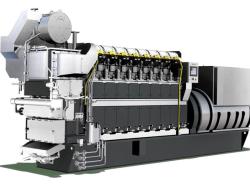
OR WAIT null SECS
© 2024 MJH Life Sciences™ and Turbomachinery Magazine. All rights reserved.
Time to replace gear couplings with dry couplings?
Gear Coupling[/caption]
Though dry couplings began to replace gear couplings as far back as the 1970s, there are still high performance gear couplings connecting critical equipment around the world. Over the past two decades most reliability programs included the gear to dry conversion but it is still a topic for discussion.
To best describe the advantages of retrofitting, consider that there are basically two types of flexible couplings; sliding and deforming. Sliding couplings are gear tooth and grid types while disc and diaphragm are examples of those that accommodate misalignment by deforming a flexible element.
This article contains excerpts from the paper, "Couplings - Balancing Tutorial & “New Developments in Gas Turbine Couplings” by Joe Corcoran of Kop-Flex & Christian Wolford of Altra Industrial Motion.
Kop Flex disc coupling[/caption]
Sliding couplings wear, require lubrication and therefore maintenance but there are many other advantages to consider when retrofitting.
Dry coupling advantages include Infinite life - no wearing components Lower forces on connected equipment 20-30% in bending moment, 10% in axial Lower repeatable unbalance (no radial clearances) Unbalance level does not change over time No lock up or spool cracking No hub to shaft fretting Field interchangeable components Less expensive
When properly applied, disc and diaphragm couplings can improve the performance of most trains initially installed with gear type couplings. However, an improperly applied coupling can create many serious problems if consideration is not given to the design differences.
Quite often couplings are used to "tune" a multiple bodied train. The rotordynamic response can be greatly influenced by a change in the coupling's mass distribution.
To simply retrofit a gear coupling based on price and delivery is a bad idea that can lead to disaster. The question then arises as to who should be involved in the retrofit process. There are two avenues available to the user- the OEM or coupling supplier. The OEM generally offers the greatest advantage but this comes at a cost. If the necessary data is available and a rotor study is not required many users prefer to deal directly with the coupling supplier. In addition to the basic information required to size a coupling, there are several issues to consider for proper retrofit selection.
The most significant coupling characteristics to be study are: • Weight and center of gravity (Cc) location. • Torsional stiffness. • Lateral critical speed. • Windage/temperature rise. • Equipment envelope. • Axial travel capacities. One of the first considerations should be to match, as closely as possible, the overhung moment of the old coupling. Since membrane couplings are less power dense they tend to be larger in diameter and heavier for the same given torque. Because of this, guidelines should be established to insure successful operation.
The following guidelines are sometimes used: • If the operating speed is less than 3,600 rpm the overhung moment of the new coupling should be within 20 percent of the existing coupling. • Between 3,600 rpm and 6,000 rpm the weight should fall within 15 percent. • Over 6,000 rpm the weight should be within 10 percent.
The sensitivity of the machines must be considered when applying these guidelines. If the coupling weight is an appreciable percentage of the rotor weight, very little deviation may be tolerated. The torsional stiffness should also be as close as possible to the existing coupling. Multiple bodied trains tend to be particularly sensitive to changes in the coupling’s torsional stiffness. It is common for end user specifications to require the stiffness to be within 10%.
If either of these criteria cannot be met, rotor dynamic analysis should be performed. When retrofitting, particularly for reduced moment designs, a basic criteria should include heat generation calculations. Heat generation relates to the coupling’s proximity to the equipment casing and guard as a function of speed. Coupling suppliers can estimate the temperature rise in the guard when given housing and guard dimensions.
Bolt windage should also be considered as part of heat generation calculation. There have been cases where dry couplings, due to low pressure created in the housing, have developed a sufficient pressure differential to pull lubricant from the machine’s bearings causing it to fail. Another “rule of thumb” is when the back face of the coupling is closer than 40mm from the bearing cage, consideration should be given to a “vacuum breaker” labyrinth.
On applications where a 50mm radial clearance exists between the coupling OD and the guard or housing, these calculations are generally not required. Gear coupling have considerable axial travel while flexible membrane couplings are limited to the fatigue properties of the elements. When retrofitting, it is important to accurately determine the shaft separation, thermal growth of the machines and the direction of that movement.
Coupling suppliers often recommend that when the axial thermal growth requirement exceeds 25% of the coupling’s capacity, it should be pre-stretched (or compressed). The “pre-stretch” is normally designed into the coupling by changing the spacer length. In most cases dry couplings have sufficient axial travel capacity.


